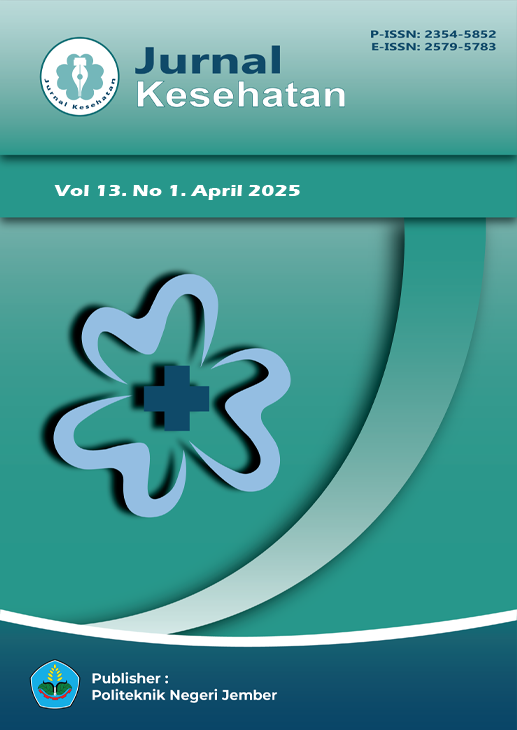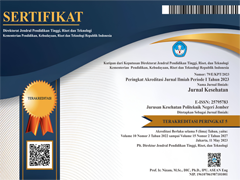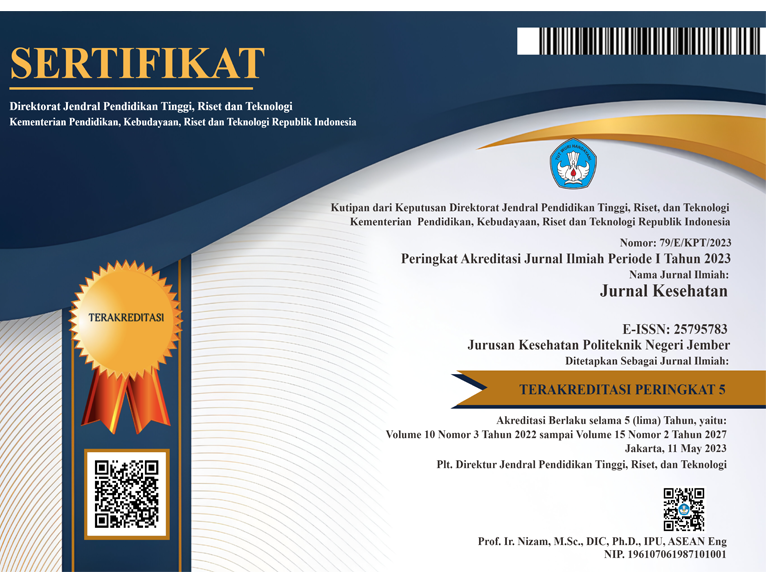Hubungan Antara Pola Konsumsi Dan Sosial Budaya Dengan Kejadian Kekurangan Energi Kronik Pada Ibu Hamil
DOI:
10.25047/j-kes.v13i1.540Downloads
Abstract
Chronic Energy Deficiency (CED) is a condition-of inadequate nutritional intake that persists over a long period (chronic), leading to health risks for pregnant women such as anemia, abortion, premature birth, intrauterine fetal death, intrauterine growth retardation (IUGR), and it is an indirect cause of maternal mortality. CED is caused by direct and indirect factors. Direct factors. This study aims to analyze the relationship between konsumsi patterns and socio-cultural factors with the incidence of CED in pregnant women in the working area of the Pakem Health Center in Bondowoso Regency. This study is a quantitative research using a cross-sectional method. The study was conducted in the working area of the Pakem Health Center in Bondowoso Regency with a simple random sampling of 49 respondents. The research was carried out from March 26, 2023, toJune 6, 2024. Primary data in this study was obtained through questionnaires covering age, education, knowledge, family income, consumption patterns, dietary restrictions, age at marriage, and direct measurements of upper arm circumference (LILA) in pregnant women. Secondary data was obtained from the Dinas Kesehatan Bondowoso and the Puskesmas Pakem related to the incidence of CED in pregnant women. Data analysis was performed using descriptive statistical analysis. The results showed that the majority of 41 respondents (83.7%) were aged 21-35 years. Most respondents completed their education up to high school/vocational school (42%). Most respondents had moderate knowledgeabout balanced nutrition and CED, with 36 respondents (73%). Most respondents (55.1%) had a low income, below the regional minimum wage of Rp 2,183,590. The consumption patterns of respondents were mostly in the poor category, with 32 respondents (65.3%). Some respondents practiced dietary restrictions during pregnancy (51%), such as avoiding ice, shrimp, durian, pineapple, squid, fermented cassava, banana hearts and chicken intestines. Some respondents had early marriages, with 18 respondents (36.7%) citing arranged marriages and societal views on the appropriate age for marriage.A total of 25 respondents (51%) experiencedCED in the working area of the Pakem Health Center in Bondowoso Regency. There was a significant relationship between consumption patterns and the incidence of CED in pregnant women in the working area of thePakem Health Center in Bondowoso Regency, with a p-value of 0.001. There was a significant relationship between socio-cultural dietary restrictions and the incidence of CED in pregnant women in the working area of the Pakem Health Center in Bondowoso Regency, with a p-value of 0.001. However, there was no significant relationship (p-value 0.196) between early marriage and the incidence of CED in pregnant women in the working area of the Pakem Health Center in Bondowoso Regency
License
Copyright (c) 2025 Ellen Registayanti Fernananda Zein, Sulistiyani Sulistiyani, Septi Nur Rachmawati

This work is licensed under a Creative Commons Attribution-ShareAlike 4.0 International License.
Authors who publish in this journal agree to the following terms:
1. Copyright belongs to the medical journal as a publication
2. The author retains copyright and grants the journal rights to the first publication carried out simultaneously under a Creative Commons Attribution License which allows others to share the work with an acknowledgment of the author's work and initial publication in this journal.
3. Authors may enter into separate additional contractual arrangements for the non-exclusive distribution of the work (eg sending it to an institutional repository or publishing it in a book) with acknowledgment of initial publication in this journal.
4. Authors are permitted and encouraged to post work online (eg in institutional repositories or on their websites) before and during the submission process, as before and larger citations of published work (see Effects of Open Access).
Selengkapnya tentang teks sumber ini














